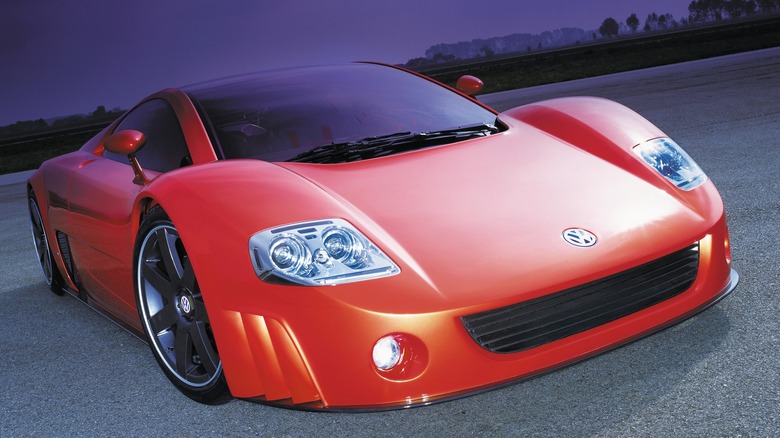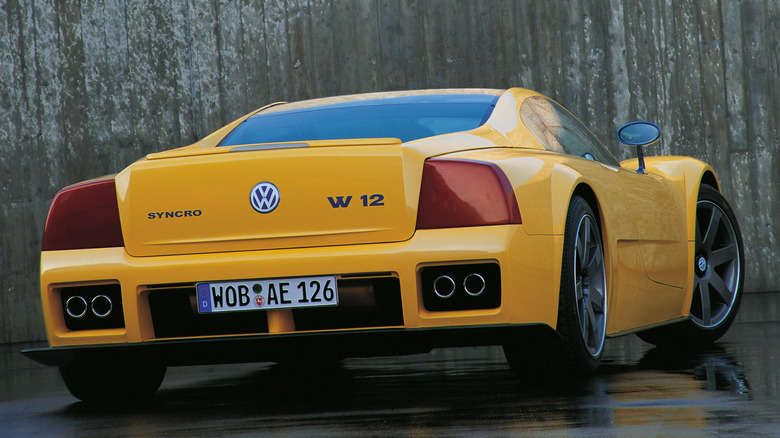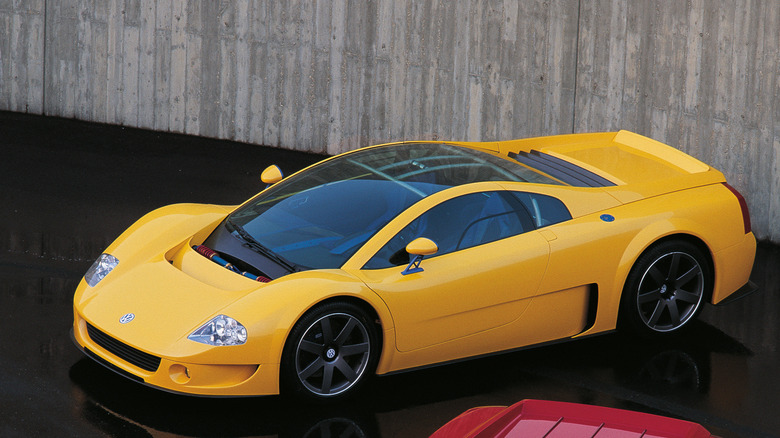This Little-Known Volkswagen Concept Inspired Bugatti's Most Iconic Car
Volkswagen wowed the crowds at the 1997 Tokyo Motor Show when it unveiled its Nardo W12 supercar concept. The German giant wanted to show off its technical prowess while also challenging the perception that it was simply a maker of dependable, practical cars — it wanted to inject some sportiness into its image.
The Nardo concept was well-received and one year later, VW revealed a roadster version of the same concept, making many believe the automaker was setting the stage for the Nardo to go into production. That never happened, but the Nardo eventually led to the creation of Bugatti's most iconic model, the W16-powered Veyron.
The Nardo's unique W12 engine was also a big discussion topic at the time, representing the culmination of a decades-long desire within the VW group to create a functioning engine with a W configuration, basically, two V engines side by side. The 1991 Audi Avus quattro Spyder concept was also supposed to have a W12 in the middle, but it didn't because such a power plant did not exist at the time. It was supposed to have a 500-horsepower 6-liter W12, but it took the VW group another decade before it could create one that worked.
The Nardo's W12 had a 5.6-liter displacement and pumped out a respectable 414 horsepower. It was created by fusing two 2.8-liter narrow-angle VR6 blocks side by side and feeding both their power into a common crankshaft. The displacement was later increased to 6 liters and the output was upped to 591 horsepower.
Serious performance and production looks
Volkswagen said the Nardo W12 weighed just 2,646 pounds and with the revised and more powerful engine, it could go from 0 to 60 mph in 3.5 seconds. That is still an impressive number today, and you could consistently come close to achieving it even in less-than-ideal traction conditions, thanks to the car's all-wheel drive system, as well as its quick-shifting six-speed sequential gearbox.
During a top-speed test held in February 2002, the Nardo achieved an average speed of 200.6 mph over a distance of 4.4 miles, breaking a world record in the process. The car went on to break six more world records relating to distance and speed, marking a successful debut for Volkswagen's W engine.
The Nardo was also seen as a very credible supercar for the day. It had the classic mid-engined supercar proportions, and there was nothing that looked out of place about it other than the badge. Volkswagen even gave it W12 and Syncro badges on the back (the latter referring to its all-wheel drive system) in a very similar style to its production cars, and it managed to make it look believable overall.
The same went for the interior, which looked a bit fancier and more supercar-like than in regular Volkswagens of the time, but it didn't look like a concept's interior. The dials, buttons, vents, and the entire center console looked like they were shared with other series Volkswagens. The 2001 version of the concept also had a working, active rear wing that rose at speed.
Form Nardo to Veyron
Volkswagen initially announced a limited 200-car production run for the Nardo and expected to sell them at $175,000 apiece, then the figure dropped to 50 cars and the price rose to $200,000. However, none of this materialized, and it would be over a decade before the VW group would finally launch a supercar with a W engine configuration, the 2005 Bugatti Veyron.
It was very similar in many respects to the Nardo: It had a W engine in the middle, an active wing in the back, and a penchant for going very quickly. However, the Veyron was a far more extreme proposition, with its 8-liter W16 that could produce just shy of 1,000 horsepower thanks to a quartet of turbochargers. It was also special because, between its power and its aerodynamic qualities, it had a top speed of 253 mph, which is over 400 km/h, and that raised a few eyebrows.
The Veyron was many times more expensive than the Nardo, but Bugatti eventually made 450 examples, and the performance numbers got even crazier toward the end of its production run. The Veyron SuperSport, whose W16 was pushed to 1,183 horsepower, was clocked at 267.91 mph (431 km/h). It could also accelerate to 62 mph (100 km/h) from a standstill in 2.5 seconds and to 124 mph (200 km/h) in a little over 7 seconds.
The Veyron's power and performance numbers don't seem that impressive today, having been surpassed not only by its successor, the Chiron, but also by cars from low-volume manufacturers like Koenigsegg or Rimac. However, it is a milestone car that defined the mid-2000s, one that drew heavily from ideas introduced with the VW Nardo W12 concept.


